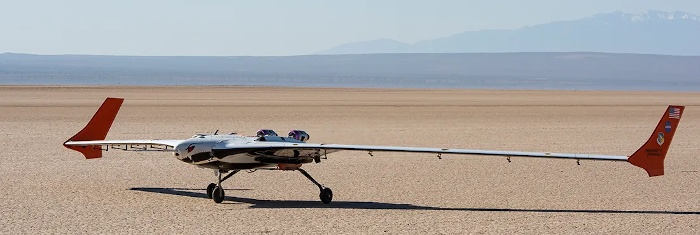Lockheed Martin X-56 MUTT
The X-56A MUTT (Multi-Utility Technology Testbed) was built to test and evaluate active aeroelastic control technologies for flutter suppression and gust load alleviation in flexible high-aspect-ratio wings. The program was a cooperation between the Air Force Research Lab (AFRL) and NASA. Airframe prime contractor Lockheed Martin had experience in the field from its own Body Freedom Flutter (BFF) research program, conducted since 2005.
 |
| Photo: NASA/Jim Ross |
| X-56A |
The X-56A was of modular design. A common centerbody could be used with different sets of exchangable wings. It was powered by two small jet engines, because propellers would create low-frequency noise, which could interfere with the flutter tests. The aircraft was equipped with video cameras to observe the wingtips in flight, to get visual data on wing flutter behavior. In case of a wing failure at altitude, the X-56A had an emergency parachute to save the aircraft.
Two X-56A aircraft were built, together with several sets of wings. The initial flight test program was run by AFRL at Edwards AFB, and the first flight occurred in July 2013. The first 16 flights used a conventional stiff wing, to check out the aircraft's handling and performance envelope. On the first flight with a flexible wing to test the active flutter control, on 19 November 2015, the X-56A crashed shortly after take-off. NASA had started flying the second X-56A in April 2015. After eight evaluation flights with the stiff wing, X-56A #2 successfully passed its initial flight with the highly flexible wings in August 2017. NASA finished its X-56A test series in 2019.
 |
| Photo: NASA/Lauren Hughes |
| X-56B |
In 2021, NASA reactived the MUTT aircraft in an improved version designated X-56B. It used the same centerbody as the X-56A, and presumably a new set of wings. The X-56B made its first on 19 April 2021. However, the test program ended prematurely, when the aircraft crashed shortly after take-off on 9 July 2021, due an unspecified "anomaly in flight".
Specifications
Note: Data given by several sources show slight variations. Figures given below may therefore be inaccurate!
Data for X-56A:
| Length | 2.3 m (7.5 ft) |
| Wingspan | 8.4 m (27.5 ft) |
| Weight | 220 kg (480 lb) |
| Speed | 222 km/h (138 mph) |
| Ceiling | ? |
| Propulsion | 2 JetCat P400 turbojets; 395 N (89 lb) each |
Main Sources
[1] Code One, Jeff Rhodes: X-56A Unmanned
Research Aircraft: MAD MUTT
[2] Wikipedia: Lockheed Martin X-56
[3] NASA: X-56B Begins New Flight Series
Back to Directory of U.S. Military Rockets and Missiles, Appendix 4
Last Updated: 24 January 2024